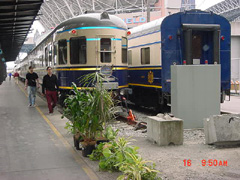6.16 Approaching Railroad Crossings, Drawbridges, and End of Multiple Main
Track
Trains and engines must be prepared to stop when they approach
railroad crossings at grade, drawbridges, and the end of multiple main track,
unless these areas are protected by block or interlocking signals.
Protected by Stop Signs
If stop signs protect these areas, the train must stop before any part of the
train or engine passes the stop sign. The train cannot proceed until the route
is clear or drawbridge position permits movement.
 Protected by Gate
Protected by Gate
If a gate is lined against the intended route, trains and engines must stop
and remain at least 50 feet from fouling the track on the conflicting route
until the gate is changed to the stop position on the conflicting route.
Where required, restore gate to its normal position after movement is
complete.
Obscured View of Conflicting Route
If a train must stop before entering a railroad crossing at grade and the
view on the conflicting route is obscured, a crew member must go ahead of the
train and signal from the crossing when it is safe to proceed.


![[Previous Page]](http://www.atdlines.com/images/previous.gif)




















![[Email Us]](http://www.atdlines.com/images/mailbutn.gif)
![[Return to Top]](http://www.atdlines.com/images/up.gif)
![Power By ETS]](http://www.atdlines.com/motion/train6.gif)
![Power By ETS]](http://www.atdlines.com/images/power.gif)
